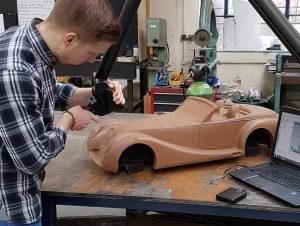Maker of ‘coaches’ bets at once on digital thread and work done by hand (http://advancedmanufacturing.org)
Morgan Motor relies heavily on humans to manufacture its retro cars, but it leaves nothing to chance
[Just another ‘proof statement’ that the MMC is not stagnant in its methods or processes. Something that gives me some assurance that they will continue for some time. Mark]
Morgan Motor Company, which HFS Morgan established in 1909 with the design of the Morgan three-wheeler, today calls its products “coaches” and caters to people “yearning for the classical look of the original Morgans and that nostalgic feel: the wind in the face, pulling the top down when the rain stops,” said Dave Olson of Verisurf Software in Southern California.
The British firm’s vehicles are also still handcrafted, he said. “Rather than using a robot to assemble parts of their frame, there’s this great attention to detail. The fixture they use to assemble and then weld that frame up is handcrafted. They haven’t lost the element of people caring about how it’s going together. A robot doesn’t care how it goes together; it’s just putting things in place, and moving a welder to weld.”

A traditional hand-styled clay model of the Morgan 4/4 [it may be just me but isn’t this a clay model of an Aero 8?? Mark] is scanned to create a digital design nominal of the surface profile.
But Morgan is by no means behind the times. To help ensure people spending sometimes $100,000 for a car get what they are after, Morgan Motor has for the last four years been using the Verisurf metrology software suite, which costs $10,000–$20,000 depending on the configuration.
Morgan Motor uses Verisurf for three primary applications:
- 3D modeling. “Verisurf uses a 3D laser and reverse-engineering technology to scan the motor car, capture a point cloud, convert that point cloud to a 3D mesh, convert the 3D mesh into NURB surfaces (a mathematical expression for complex profile surfaces), and finally create a watertight solid model that can be used for manufacturing,” Olson said.
- Tool-building. “Verisurf is used to assemble fixtures, toolings and jigs that are used to assemble the automobile. Verisurf works with a variety of metrology devices, including laser trackers and portable CMM arms to position mounting holes, and position tooling, and jigs, and clamps so that the assemblers can assemble the frame and weld it up, and/or assemble the frame and glue and screw it together. And create assembly fixtures for wiring harnesses,” he said.
- Dimensional inspection and quality reporting. “The software is used to connect with pretty much any brand of portable CMM and/or stationary CMM, but in this case they were using primarily portable CMM arms,” Olson said. “They use that to take measurement inspection points and compare them to the CAD model, and display the deviation and create deviation reports, if any, in order to track the quality of their manufacturing process.”
The primary benefits: speed of development, manufacture and inspection.
“It’s all about time to market, or getting the design to market quickly,” he said. “Another major benefit is the improvement in quality. In order to improve quality, you must be able to measure your current conditions and have set goals for improvements, and then measure those.”
And then there is the money saved by reducing scrap. If you get it right the first time, scrap reduction is a tangential benefit.
“If you can implement in-process measurement, you can head off major errors sooner, reduce scrap, and often times save parts that [would otherwise be] scrapped, maybe ones to which you have added a lot of value,” Olson said. “When you look at cost, schedule, and quality, Verisurf helps manufacturers address all of the three major aspects of that product manufacturing.”
Morgan Motor also needs software like Verisurf’s to help it with its production part approval process, aka a “first article inspection report,” required by upper management.
Morgan Motor uses Verisurf’s software along with the Hexagon Romer articulating scanning arm.
Production line players submit those reports as if to say, “Look, everything is in place: We have all the individual parts. We have the production approval process in place. Give us permission to buy material, and I’ll produce x-number of vehicles.”
Verisurf, which founder Ernie Husted named when he designed the software for the verification of surfaces, is also used by Honda and Nissan.
But its largest uptake has been in the industry that’s really stuck on three-wheelers: aerospace. Airbus, Boeing, Bombardier, Lockheed Martin and Northrop Grumman.
The thing they all have in common: “Mission critical components,” Olson noted. “If there’s a problem in making them, lawyers get involved.”
To avoid legal issues, manufacturers use model-based definition (MBD) workflow—to maintain data integrity and relevance as part of the overall design and manufacturing process.
For Morgan, a key requirement in selecting a measurement solution was that it had to be based on a CAD platform, he said.
When using MBD, the CAD model is the nominal against which all parts are measured and inspected, keeping the all-important digital thread intact—from design to manufacturing to inspection and quality reporting.
Everything that defines the part exists in a single digital archive, including how to manufacture and inspect the part.
In the end, then, Morgan Motor cars rely at once on humans to sculpt them and digitized data to verify those sculptors of sorts did their magic as expected.
